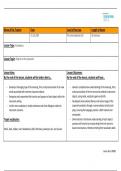Name of the Teacher Date Level of the class Length of lesson
01.10.2024 Pre-intermediate (A2) 60 minutes
Lesson Type: Vocabulary
Lesson Topic: Objects in the classroom
Lesson Aims: Lesson Outcomes:
By the end of the lesson, students will be better able to… By the end of the lesson, students will have…
Develop a thorough grasp of the meaning, form, and pronunciation of ten new Gained a comprehensive understanding of the meaning, form,
words associated with common classroom objects. and pronunciation of the ten new words related to classroom
Recognize and comprehend the function and purpose of each object within the objects, using realia, vocabulary game and drills.
classroom setting. Developed conversational fluency and natural usage of the
Use the new vocabulary in simple sentences and short dialogues related to acquired vocabulary through a conversational activity (role
classroom scenarios. play), ensuring the language practice is both relevant and
memorable.
Target vocabulary: Demonstrated a functional understanding of each object's
purpose and function by incorporating them into scenario-
Pencil, desk, rubber, ruler, blackboard, shelf, dictionary, bookcase, bin, and scissors based conversations, thereby enriching their vocabulary bank.
Lesson plan 150823
,Anticipated difficulties: Suggested solutions:
Include one relating to L1/age/level of the students and one for the 10
words (meaning, form, or pronunciation). 1. Provide bilingual support when introducing new concepts. Encourage
comparisons between languages to enhance understanding. Provide
explicit explanations and examples to address common pitfalls.
1. L1 (First Language - Chinese): Establish a language-use rule at the beginning of the lesson,
Students may face challenges in transferring concepts and structures from their highlighting the benefits of speaking only English.
first language (Chinese) to English.
The monolingual nature of the class may cause the students to revert to their
native language (L1) when encountering challenges or difficulties during the 2. Incorporate interactive and age-appropriate activities, games, and
lesson. visuals to keep the lesson dynamic and capture their interest. Break
the lesson into shorter segments to sustain focus.
2. Age (11-12):
Maintaining the attention and engagement of 11-12-year-olds for the entire
60-minute duration can be challenging. 3. Provide ample opportunities for controlled practice and gradually
introduce more challenging tasks. Offer scaffolded support by
providing sentence frames or prompts to help them express
3. Level of the student (A2): themselves. Simplify language as much as possible and encourage
The pre-intermediate level may pose difficulties in grasping more complex peer collaboration. Offer additional support for students struggling
language structures and expressions. with comprehension.
Simplifying the explanation of word meanings might pose a slight challenge
when instructing learners at this level of acquiring the target language. 4. Implement a variety of activities for each word, including visual aids,
real objects, and pronunciation drills. Encourage repetition and
4. Target Language (10 words): provide opportunities for continuous reinforcement. Enhance
Students may find it challenging to remember the meaning and form of all ten comprehension and make connections between the target words and
words due to differences in syntax, grammar, and vocabulary. their meanings. Provide physical demonstrations of sounds and offer
Student may struggle with the pronunciation of English consonants /l/ and practice activities that focus on minimal pairs to help students
/r//, as these sounds do not exist in their native language, impeding their ability differentiate between the /l/ and /r/ sounds. Incorporate games and
to accurately learn and pronounce words like "ruler" and "rubber." ample practice opportunities to improve pronunciation skills.
Lesson plan 150823
, Language analysis:
Language Meaning of the item How you will present meaning Concept Checking Questions Grammatical Pronunciation
Item form Use the IPA
translator if
needed
1. Pencil A narrow piece of wood, Show a pencil to the students, Can you draw with a pencil? (Yes) Noun /ˈpensl/
or a metal or plastic case, and explain, that is used for Is it used for writing or colouring?
containing a black or writing and drawing. (Both)
coloured substance, used Demonstrate by writing on a Is it made of wood only? (No)
for drawing or writing. piece of paper.
2. Desk An object with a flat top Point to a desk in the classroom Is a desk used for sleeping? (No) Noun /desk/
like a table, often with to draw students' attention to it Can you write on a desk? (Yes)
drawers, where you can and explain that it is where we Does it usually have drawers?
study or do your work. sit to study and do work. (Yes)
3. Rubber A small tool, typically Show a rubber and explain that it Is it used to remove pencil Noun /ˈrʌbə(r)/
made of rubber or a similar is used to remove pencil marks marks? (Yes)
substance, used to remove and is also known as an eraser. Can you use it to write? (No)
pencil marks from paper. Write on paper and invite a Is it usually made of metal? (No)
student to demonstrate. What is the other name for a
rubber? (Eraser)
4. Ruler A straight, flat, thin strip Show a ruler to the students, Is a ruler used for measuring? Noun /ˈruːlə(r)/
of wood, metal, or plastic pointing out the markings for (Yes)
marked with units of measurement. Can it draw straight lines? (Yes)
Lesson plan 150823




